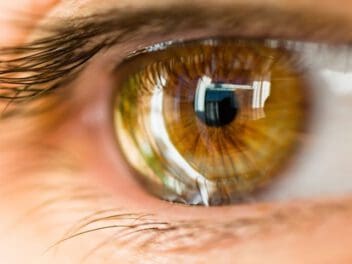
Medically Reviewed by Johnny Khoury, M.D.
Can You Receive LASIK on Both Eyes at Once?
Last Updated:

Medically Reviewed by Johnny Khoury, M.D.
Table of Contents
Typically, LASIK is performed on both eyes at the same time on the same day.
LASIK is an effective and fast procedure with a relatively quick recovery time. Having LASIK performed on both eyes on the same day is more convenient than doing each eye separately.
Separating your LASIK surgery into two procedures can allow for you and your doctor to see how your first eye will handle the surgery before proceeding to the second eye. It can also be useful to create monovision with presbyopia.
Discuss your LASIK options with your surgeon to best determine if you should do both eyes at the same time or on different days.
LASIK: Quick & Effective

LASIK, or laser-assisted in situ keratomileusis, is a common procedure that reshapes your cornea to correct vision. Refractive errors, such as myopia (nearsightedness), astigmatism (misshapen cornea), and hyperopia (farsightedness), can be successfully treated with LASIK. In fact, 96 percent of people who get LASIK are satisfied with the outcome.
Most of the time, LASIK is done in both eyes on the same day. The surgery itself is fast; typically, the entire thing is done in less than 30 minutes. The actual laser part of the surgery often only takes a few minutes, as the majority of the time is spent preparing for the surgery, talking with the surgeon, and aftercare.
You deserve clear vision. We can help.
With 135+ locations and over 2.5 million procedures performed, our board-certified eye surgeons deliver results you can trust. Your journey to better vision starts here.
Your eyes will be numbed during the procedure. Specialized tools will help to hold your eyes still during LASIK. The procedure is generally over before you even know it.
Nine out of ten people who get LASIK obtain vision that is between 20/20 and 20/40 without prescription contact lenses or eyeglasses. The main goal of LASIK surgery is to improve your eyesight and potentially reduce your need for prescription eyewear.
Overall, LASIK is considered a safe procedure with good long-term results. It can easily be done on both eyes at once.
Advantages to Having Both Eyes Treated at Once
There are a number of benefits to having LASIK surgery on both eyes in the same session.
Convenience
You only have to come in for the procedure one time instead of waiting for the first eye to heal and then going back for the second eye. You will only need someone to drive you home from the procedure once instead of twice.
Faster recovery
It typically only takes a few days for your eyes to heal from LASIK. When getting them both done at once, you only have to go through this healing process once, which can get you back to your everyday activities sooner.
Less time out of work
You will often see clearly within 24 to 48 hours after LASIK. When getting both eyes done at the same time, you will usually only need a few days off work. You will need to talk to your doctor about how much time to take off, as each person’s work environment and duties are different
Quicker time for your eyes to stabilize
Typically, your vision will stabilize within three to six months after LASIK. When you have both eyes done at once, you only have to wait through this period of stabilization once.
Your ophthalmologist will work with you to measure your eyes, determine your candidacy for LASIK in general, and help you decide if it is best to have both eyes done at once or to separate LASIK into one eye at a time.
When to Do LASIK in One Eye at a Time

There are some instances where it is best to have LASIK performed on each eye individually. As with any surgery, there are potential risks with LASIK, although complications are rare. It can be less risky to have one eye done first to see the results. Your surgeon can then determine how to best proceed with the second eye.
The other reason to have LASIK done on only one eye at a time is when you have presbyopia, which is a condition that occurs with aging and causes nearsightedness. LASIK cannot treat presbyopia directly, but in some cases, creating monovision can help. This means correcting one eye for distance (usually your dominant eye) and the other eye for near (usually your non-dominant eye).
Monovision for presbyopia can also be achieved by correcting each eye differently with LASIK surgery. One eye is corrected for far vision and the other for near vision. In this case, each eye could be treated separately and on different occasions. Your surgeon will determine how long you will need to wait to have the second eye done after the first surgery. However, most surgeons will still treat both eyes at once with the dominant eye treated for far vision, and the non-dominant eye for near vision.
Often, an eye doctor will recommend that you try out monovision with contact lenses first to make sure that you and your eyes can tolerate it before scheduling a LASIK surgery. Your eye care professional is the best resource for helping you determine optimal treatments for your eyes. In most cases, LASIK is performed simultaneously with high success rates.
You deserve clear vision. We can help.
With 135+ locations and over 2.5 million procedures performed, our board-certified eye surgeons deliver results you can trust. Your journey to better vision starts here.
References
- LASIK Complication Rate: The Latest Facts and Stats You Should Know. (October 2017). American Refractive Surgery Council (ARSC).
- What Should I Expect Before, During, and After Surgery? (July 2018). U.S. Food and Drug Administration (FDA).
- LASIK- Laser Eye Surgery. (October 2020). American Academy of Ophthalmology (AAO).
- Have You Seen the 10-Year Long Term Safety Data on LASIK? (December 2006). Journal of Refractive Surgery.
- Facts About LASIK Complications. (December 2018). American Academy of Ophthalmology (AAO).
- What Is Presbyopia? (January 2020). American Academy of Ophthalmology (AAO).
- Presbyopia Treatment. (January 2020). American Academy of Ophthalmology (AAO).

Dr. Johnny Khoury, a Johns Hopkins and Washington University double fellowship trained surgeon, is among the world’s most experienced refractive surgeons. His experience in excimer laser refractive surgery dates back to 1994.
This content is for informational purposes only. It may have been reviewed by a licensed physician, but is not intended to serve as a substitute for professional medical advice. Always consult your healthcare provider with any health concerns. For more, read our Privacy Policy and Editorial Policy.